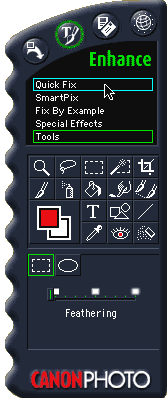Review: Canon Photo

Company: Canon Software
Web: http://www.software.canon.com
Requirements: Power Mac, System 7.5 or higher, 32 MB of RAM, 80 MB disk space
Price: $34.95
As you’d expect from a division of Canon, this photo manipulation software is excellent. It’s a winner in every way. And as you’d expect from a major publisher with deep roots in Windows, the company’s sales department is not quite up to speed on its Mac products.
It sure is nice to see Canon getting on the Mac bandwagon. So often, when big companies get in the software business, they look at the huge installed base of Windows machines, look at the less huge installed base of Macs, and say, “There’s a big pile of money (Windows) and a small pile of money (Macintosh), so let’s not be idiots, let’s take the big pile!”
Sometimes I call PR departments and ask if a Mac version of some program is in the works, and they chuckle and patiently explain the above paragraph to me. I’ve heard it often enough that I don’t bother pointing out the fallacies, which are:
- You don’t actually get the big pile of money, you get your market share of the big pile of money. If lots of companies are squabbling over the big pile, your share may not be very big.
- Both the money piles are big piles. You needn’t give up the Windows pile to enjoy the Mac pile too.
- Thanks to the iMac, Macintosh is very strong in the home and new user markets, and has always been strong in graphics markets. Sure, if your product is customer scheduling software for dentists’ offices, Windows may cover the market, but for a low cost-photo manipulation product where your main selling points are high quality and ease of use...how many of your potential customers have gumdrop colored Macs on their desks or on their laps? [Hint: more than a couple million.]
Apparently, Canon Software (a division of Canon Computer, which is a division of Canon Camera) figured this out for itself.
Canon Photo for Mac coexists with a Windows product, so we’d expect a bit of interface weirdness, right? Well, we get it, but it’s not your usual trying-to-be-Windows weirdness, it’s more the MetaCreations-Bryce-and-Power-Goo weirdness: not what you were expecting, but clear and easy when you get the hang of it.
I may be showing my own prejudice. I’ve been using Mac OS for so long that the Mac interface seems “intuitive” to me, but with Mac OS X hurtling toward us I may soon have to intuit a whole new set of responses. It’s possible the Canon Photo interface is more “intuitive” (a word which used to refer to intuition, and has degenerated to meaning “similar to what you already know how to do”) than the Mac, since its interface is patterned after that most ubiquitous symbol of public access to technology, the TV remote control.
The Tools palette includes most of the high-end photo tools, such as a Crop tool (upper right), a Magic Wand (one left of the Crop tool), and a Clone tool (the linked brushes below the Crop tool), plus a Red Eye Removal and Dust Removal tools (bottom right). The Red Eye tool erases red only, and replaces it with a similar value of gray, thus making your kids seem human in flash pictures and avoiding the Little Baby Dameon look.
The four icons atop the remote control symbolize Get, Enhance, Share, and Internet.
Click the “Get” button, and you get four source options: Disk, Camera, Scanner, and Internet. “Disk” sends you through the usual hierarchical menu routine we all know and love. Select Open Picture from the File menu, and away you go; and “Scanner” (duh) lets you acquire direct from a scanner. The “Camera” option is nice, in that you can download from a digital camera without messing with any other software, and the “Internet” option offers you a variety of Web sites to search (presuming you have an Internet connection).
Now that you have something on the monitor, the next button puts you in Enhance mode.
Here’s a typical amateurish photo, of two guys hanging around an Alp, taken by a paperazzoid with a cardboard camera costing less than $10. It was blown up to a 4 x 6 print, scanned on a $99 (street price) flatbed scanner, and saved as a JPEG. Thanks to a witty caption and some topical interest (That’s me getting instruction on how to stand like an action hero, and the caption was, “No, it’s shoulders back, stomach in!”), that photo was printed as-is in a trade publication.

Egotist that I am (that’s me on the right, by the way), I rather liked that picture. It might be crisper if it had been shot with an $18 camera instead of a $9 camera, but the magazine was in a rush, and as a story illustration, it did just fine the way it was.
And since I have it filed on my iMac as ActionHeros.jpg, and since the Mac shows files in alphabetical order, this was the first photo I opened in Canon Photo. I switched to Enhance, clicked QuickFix, and...voila!

Is that a significant improvement, or what? The subjects have lost the washed-out look and their features are crisper. The people in the background are more colorful. Even the stonework looks richer and more detailed.
Sure, a hot Photoshop artist with the proper filters (probably Sharpen Intensify from Kai’s Power Tools) could have produced similar results in not much more time, and an adequate Photoshop craftsperson could have done it in an hour of messing with Unsharp Mask and Histogram and Color Balance and assorted sliders for Radius and Threshold, but nobody could do this in the first two minutes of the first time they use Photoshop.
I have a friend who is not yet hip to the arcane ways of computers. She understands them on the level that five-year-olds understand television—if you push the right button at the right time, Barney comes on—so when I called her over to see this amazing transition, she put on her Queen Victoria we-are-not-amazed face and said, “Good, it doesn’t look blurry and snowy any more. So? Computers are supposed to do stuff like that, aren’t they?”
Well yeah, it’s just impressive when a program will do that for $34.95 and one click of a button.
She pointed to the button. “But it says, ‘Quick Fix.’ That’s what you wanted, isn’t it?”
Yes it was. She took it in stride, while I sat there like the aforementioned five-year-old when first confronted by the Thermos Bottle Mystery—it keeps cold things cold, it keeps hot things hot: how does it know?

If you have your own idea of how a photo should be improved, or are looking for a particular effect, select Fix By Example. On the left of your screen, you’ll get nine thumbnails showing eight different versions of the effect you are applying, Intensity in this example, surrounding a snippet of your original...while on the right, your remote gives you a selection of characteristics to change, an Amount of Oomph slider (that’s a technical graphics term meaning a slider with a “+” sign on one end and a “-” sign on the other), with a few work-in-progress thumbnails nearby.
Click on the thumbnail you like best (I chose the center left), and up pop nine more thumbnails, eight new ones surrounding the one you selected. You can adjust Brightness, Tint, and Sharpness the same way.
I prefer to set the Oomph slider (they don’t really call it that) to Minimum Oomph, and make changes in a bunch of little steps. I don’t say to myself, “This needs about seven degrees clockwise hue,” I say, “The middle left picture looks nicer than the other ones,” which is not only more intuitive, it keeps my self from wondering, “Clockwise hue? What on earth are you talking about?”
And like all modern photo editing programs, Canon Photo has a wealth of special effects you can overuse. Squishes and Textures and Paints, oh my!

The Special Effects shown here are (left to right) Under Glass, Cool Edges, and Oil Paint, and (top to bottom) Fracture, Puzzle, and Emboss. Great fun, and I expect to see all these effects in your upcoming birthday cards, interoffice memos, and ransom notes.
The package also includes some nifty features like an Internet postcard creation and distribution system, and templates for everything from awards to baby shower invitations to calendars, and so on. But that’s all frosting on the cake, and I doubt I’ll ever use those features in real life.
The reason I’m giving Canon Photo the coveted Excellent rating is that it is so good at what it’s designed to do. I didn’t give it extra credit for its extra features (if you like ’em, use ’em, if you don’t, ignore them) nor did I give it demerits for extra features it lacks.
Listen, friends, Canon Photo is not going to replace Photoshop. Photoshop is a professional tool with many professional features (layers, for example), and people who make a career of photo manipulation need that kind of power. But photo editing for the rest of us?
For amateur and hobby photography, using Photoshop is like killing flies with a sledge hammer. Compared to the Photoshop/KPT combo gracing professional workstations, Canon Photo is 1/20 the price and at least 10 times easier to use.
It’s even suitable for low-end pro use, such as a freelance writer that needs to illustrate his stories. This story, for example, was illustrated exclusively with Canon Photo—all the shrinks and crops and background removals—and I may never transmit another electronic photo without giving it a hit of Quick Fix first.
This is an excellent introductory photo editing product, powerful enough for prosumer needs, and priced lower than (for example) a shareware screen capture utility. At $34.95 it’s probably the best deal in its market.
I’m not yet impressed by Canon Software’s support of this product, but I hope to be impressed by February. At this writing, the Mac version is a brand new product in the line, and the sales department is clearly confused by it. For example, searching the Web site, I couldn’t find any way to buy Canon Photo for Mac—every link led back to the PC version. It doesn’t matter what the price is if you can’t find anyone to take your money. Canon Software assures us this will be fixed by the time you read this article.
Reader Comments (6)
Add A Comment